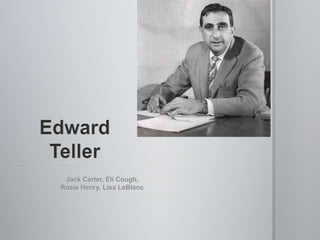
Edward teller final
- 1. Edward Teller Jack Carter, Eli Cough, Rosie Henry, Lisa LeBlanc
- 4. He transferred to university of Munich in 1928 to study quantum mechanics
- 7. Adolf Hitler came to power so Teller emigrate to Denmark in 1934, here he joined the Institution of Theoretical Physics
- 9. In Washington Teller worked with Gamow they created the Gamow-Teller rules for classifying subatomic particle behavior in radioactive decay They also attempted to apply the atomic phenomena to astrophysics He thought he was going to have a quiet academic life but the events in Europe interfered
- 13. Arrived two months late to Chicago Metallurgical lab, where he participated in the theoretical division
- 14. Moved to Los Alamos in 1943
- 15. While Teller was in Los Alamos, Szilard was in Chicago and asked Teller to start a petition to just demonstrate the bomb not drop it
- 17. Constantly brought up discussion of a fusion weapon that was suggested to him by Fermi
- 18. Discovered the method of implosion; at high pressure a less critical mass was needed, therefore pre-detonation problems with plutonium were solved
- 20. From 1944-1946 worked on only General and Super group theory
- 22. Teller took offense to Bethe asking him to work on “impossible equations”, beginning of the end of their friendship
- 24. A summary of how the scientist felt about the decision to use the bomb(s) on Japan After the bomb was dropped on Hiroshima, Teller admits to having two immediate regrets: a “weak” regret and a “strong regret.”
- 26. Szilard requested that Teller sign and pass on a petition.
- 27. Teller consulted Oppenheimer, who turned down the request.
- 30. Teller’s regret was that he did not give more thought to this problem.
- 31. Looking back, Teller agrees “a demonstration of an atomic bomb over Tokyo Bay, where the emperor and the Japanese people would have seen it but the danger would have been minimal” would have sufficed, if the bomb was to work. “If it does not go off, then we have done nothing.”
- 32. Even to this day Teller does not regret the USE of the atomic bomb.
- 34. The scientists are responsible for “the effectiveness of the tools and for the understanding of the tools,” but “not for the use of these tools.”
- 36. The Hydrogen Bomb Developed in 1951 by Teller and Stainslaw Ulam Teller’s original designs for thermonuclear bomb wouldn’t work, Ulam came up with a design that would. Teller-Ulam design: different parts of the weapon are chained together in steps, detonation of each step provides energy to ignite the next.
- 37. Hydrogen bomb cont. Teller’s design worked beginning with an implosion fission bomb as the trigger. This was referred to as the “primary” section of the hydrogen bomb. This implosion fission bomb is the same as the implosion design used in the atomic bomb “Fat Man.”
- 38. Hydrogen bomb cont. After the implosion bomb goes off, energy released in the form of X-rays compresses cylinder of “secondary” section of the hydrogen bomb. This secondary section containing a U-238 shield and tamper around Lithium deuterate and a plutonium rod, becomes compressed. The compression of the secondary by X-rays coming from the fission reaction is called radiation implosion. Because of the shape of the plutonium rod, it is not a critical mass until it is compressed.
- 39. Hydrogen bomb cont. The compressed plutonium rod undergoes fission, further heating the compressed lithium deuterate to a temperature high enough to induce fusion. The fission of the plutonium rod supplies the neutrons that react with the lithium to create tritum for fusion. The tritum-deuterium (and also deuterium-deuterium) atoms collide and combine--the process called fusion--forming helium, heat, and radiation. All of this happens in 600 billionths of a second and the result is an explosion 700 times greater than the Little Boy explosion.
- 40. Diagram of Hydrogen Bomb Process
- 41. Oppenheimer Controversy Teller was called as a witness in Oppenheimer’s security clearance hearing When asked if Teller believed Oppenheimer to be a security risk, he responded: “I have seen Dr. Oppenheimer act in a way which for me was exceedingly hard to understand. I thoroughly disagreed with him in numerous issues and his actions frankly appeared to me confused and complicated. To this extent I feel I would like to see the vital interests of this country in hands which I understand better, and therefore trust more”
- 42. Oppenheimer Controversy cont. Oppenheimer’s security clearance was revoked Teller’s former colleagues disagreed with his testimony and he became an outcast among his fellow scientists Teller then began to work with government and military on the advancement of American technological supremacy
- 43. Strategic Defense Initiative Led a strong campaign for “Star Wars”, traveling to different government agencies and countries It was a system of satellites that used atomic weapons to fire lasers at incoming missiles Traveled to Israel, invited them to join SDI, along with Japan, West Germany, Great Britain, Italy, and France
- 44. Further work with Nuclear Weapons It was said that “[Teller] deserves much of the credit (or blame)…for the failure of the 1963 Nuclear Test Ban Treaty”. Teller strongly believed in continuing nuclear research http://www.achievement.org/autodoc/page/tel0int-5
- 45. Further work cont. Director of the Lawrence Livermore National Laboratory, where he continued to work on nuclear development ( a friendly rival to the lab at Los Alamos) Professor of Physics at UC Berkeley Operation Plowshare: non military use of explosives, such as creating harbors